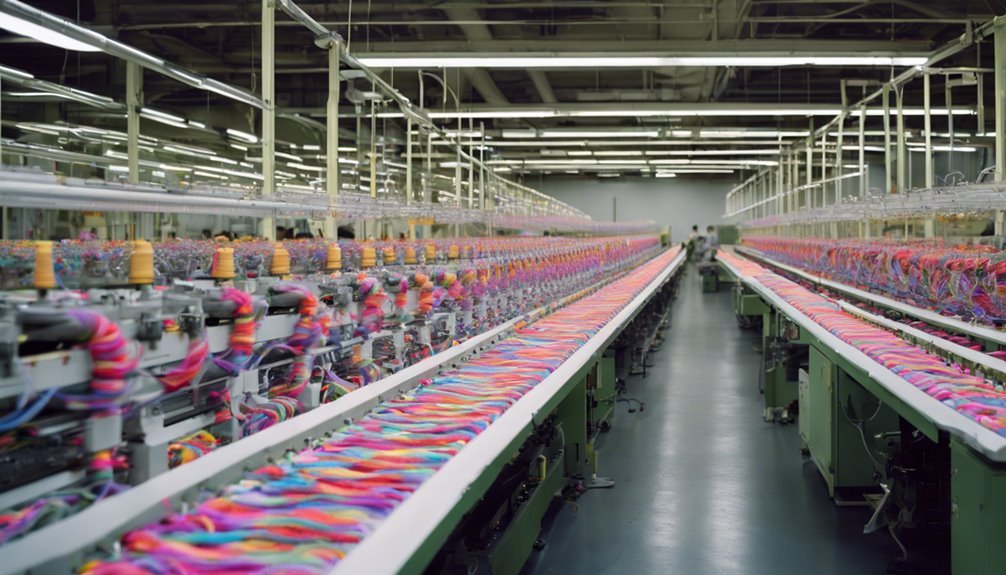How the Industrial Revolution Changed the Way Socks Are Made
Have you ever noticed how socks seem to be everywhere, yet we rarely think about how they are made?
Imagine a time when socks were a luxury item, painstakingly crafted by hand. The Industrial Revolution transformed this scenario by introducing mechanized knitting machines that improved precision and efficiency, far surpassing the labor-intensive hand-knitting methods.
With the advent of steam power and electricity, factories were able to increase production, making socks affordable for everyone. Innovations in materials and design further enhanced comfort and sustainability, democratizing access and allowing for a wide range of styles and fits.
To uncover how these advancements reshaped the textile industry, delve deeper into this fascinating evolution.
The Rise of Mechanized Knitting Machines

As the Industrial Revolution gained momentum, the advent of mechanized knitting machines marked a pivotal shift in textile production. You can imagine the transformative power these machines brought, with their mechanized efficiency enabling rapid and consistent output. Suddenly, the labor-intensive art of hand-knitting was replaced with a process that promised not only speed but also knitting precision. These machines crafted socks that fit better and wore longer, liberating consumers and producers alike from the constraints of manual labor. By embracing this new technology, you see how individuals gained more time and freedom, no longer tethered to the endless hours once required to produce a single garment. The rise of mechanized knitting machines redefined the textile industry and democratized access to quality socks.
Innovations in Sock Materials and Designs
While mechanized knitting machines revolutionized sock production, the evolution didn't stop there. You might think socks are simple, but their journey involves cutting-edge innovations. Today's socks are crafted from sustainable materials like bamboo and recycled fibers, reducing environmental impact and aligning with eco-conscious values. These materials not only conserve resources but also offer breathability and comfort.
In parallel, ergonomic designs have transformed how socks fit and function, prioritizing freedom of movement and support. Features such as arch compression and seamless toes guarantee your feet are cradled comfortably, whether you're running a marathon or lounging at home. These advancements reflect a shift towards personalized comfort and sustainability, catering to your desire for products that align with both freedom and responsibility.
Economic Impact on Sock Production and Pricing

Though the sock industry has seen remarkable innovations, its economic landscape remains complex and dynamic. You'll notice that the supply chain has become more intricate, affecting both production and pricing. The labor costs are a pivotal factor, as they influence how efficiently socks are produced and at what price they reach consumers. Consider the following:
| Factor | Impact on Pricing |
|---|---|
| Labor Costs | Higher costs increase prices |
| Raw Material Supply | Scarcity raises prices |
| Transportation | Expensive logistics inflate costs |
| Market Demand | High demand can raise prices |
Understanding these variables empowers you to navigate the market with insight. Labor costs can fluctuate based on regional economic policies, while supply chain disruptions can lead to sudden price hikes. This dynamic keeps the sock industry both challenging and rewarding.
The Role of Steam and Electricity in Sock Manufacturing
Emerging technologies like steam power and electricity revolutionized sock manufacturing during the Industrial Revolution, fundamentally altering production processes. You might wonder how exactly these advances changed the industry. Here's how:
- Steam Power: With steam engines, factories operated on a larger scale, increasing productivity. This meant more socks could be produced in less time, meeting growing consumer demand.
- Electric Efficiency: Electricity introduced precision and speed, allowing machines to function more reliably. Electric looms reduced manual labor and improved the uniformity of sock products.
- Integrated Systems: Combining steam and electricity fostered innovative machines, streamlining the entire manufacturing process. This integration reduced costs and expanded production capabilities.
These technological shifts gave manufacturers the freedom to produce higher-quality socks more efficiently, marking a pivotal transformation in the textile industry.
Social Changes and the Accessibility of Socks

As the Industrial Revolution progressed, the increased accessibility of socks signified a profound social transformation. You couldn't ignore how this era fueled social equality, as socks became affordable for everyone, not just the elite. Factories could mass-produce socks, breaking down previous economic barriers. Suddenly, fashion accessibility was within reach, allowing you to express individuality without the constraints of class.
In this context, socks became more than just a necessity; they were symbols of newfound freedom. You could choose patterns and colors, aligning with personal tastes rather than dictated by societal hierarchies. This democratization of fashion meant that your choices weren't limited by wealth. With mass production, the once-exclusive became inclusive, reshaping the social landscape and empowering you to define your own identity.
Frequently Asked Questions
How Did the Industrial Revolution Affect Sock Distribution and Retail?
You'll see how sock marketing and retail evolution transformed as mass production enabled wider distribution networks. This shift provided consumers more choices and freedom, allowing them to access diverse sock styles and brands than ever before.
What Were the Environmental Impacts of Sock Production During the Industrial Revolution?
Ever wondered about the price of progress? During the industrial revolution, sock production saw pollution increase and resource depletion. Factories released harmful emissions, while the demand for raw materials drained natural resources, threatening environmental balance and liberty.
How Did the Industrial Revolution Influence Sock Fashion Trends?
You're exploring how the Industrial Revolution's innovations in knitting machinery and dyeing techniques transformed sock fashion. It introduced vibrant color patterns and diverse material choices, offering unprecedented freedom in personal expression through fashion.
Were Any Traditional Sock-Making Techniques Preserved Post-Industrial Revolution?
You'll find that while machinery dominated, traditional craftsmanship lived on. Artisanal techniques were preserved by dedicated craftsmen, juxtaposing mass production. This balance of innovation and heritage offers a unique, timeless freedom in sock creation, celebrating individuality and history.
Did the Industrial Revolution Lead to Global Trade in the Sock Industry?
You'd notice the Industrial Revolution's impact on global sock trade through enhanced supply chains and textile innovations. These advancements enabled mass production and international distribution, offering consumers more choices and freedom in selecting sock styles and materials.







